An electrochemical immunosensor for detection of a breast cancer biomarker based on antiHER2–iron oxide nanoparticle bioconjugates
Abstract
A label free immunosensor was designed for ultra-detection of human epidermal growth factor receptor 2 (HER2) in real samples using a differential pulse voltammetry (DPV) method. In a separate process, antiHER2 antibodies were attached to iron oxide nanoparticles (Fe3O4 NPs) to form stable bioconjugates which were later laid over the gold electrode surface. In this way, by the advantage of their long terminals, the bioconjugates provided the most possible space for the immuno-reaction between biomolecules. Under optimal conditions, the immunosensor was responsive to HER2 concentrations over the ranges of 0.01–10 ng mL−1 and 10–100 ng mL−1 linearly and benefited from a satisfactory detection limit as low as 0.995 pg mL−1 and a favorable sensitivity as sharp as 5.921 μA mL ng−1. The reliability of the method in clinical analysis was proved by successful quantization of HER2 levels in serum samples obtained from patients. Furthermore, the precision and the stability of the method were evaluated and verified to be acceptable in immunoassay studies.


 Please wait while we load your content...
Please wait while we load your content...